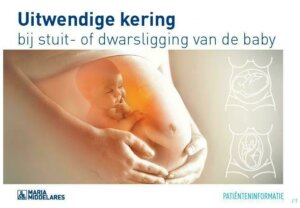External version for breech presentation
What is it?
What is it?If your baby is in breech position, its head is at the top of the uterus with its bottom lower in the uterus. Most babies turn spontaneously and are head down before week 34 of the pregnancy. Afterwards, the probability of the baby turning on its own falls dramatically, especially if it is your first child. A baby born in breech position is associated with an increased risk of complications, for vaginal births as well as for cesaerean sections. For this reason, we try - in consultation with you and depending on a number of factors - to turn the baby into head-down position. This is called
an external version.
How often does it occur?
During the first seven months of pregnancy, breech presentation is common. At 32 weeks, approximately 15% of babies are breech and they can still turn their head down easily and spontaneously. After 37 weeks, only 3 - 4% of babies are breech and the probability of turning to head-down position spontaneously is small.
Cause
In 85% of cases, there is no cause for the breech presentation. In another 15% of the cases, the breech presentation may be a result of:
- an abnormality of the mother's pelvis or uterus
- the placenta covering the cervix (placenta previa)
- too much or too little amniotic fluid
- a congenital defect with the baby

The ideal time for an external version
- For a first child: around week 35-36 of pregnancy.
- For a second or subsequent child: around week 37-38.
Before this stage of the pregnancy, the chance that the baby spontaneously turns to have its head down is quite high. Or, it is also possible that, after a successful version, the baby flips back to breech presentation.
What is the probability of success?
The probability that an external version is successful depends on many things. The following factors increase the chance of success:
- an experienced gynaecologist
- a relaxed uterus
- not having the baby's bottom deep in the mother's pelvis
- a previous vaginal birth
- a large amount of amniotic fluid
- a complete breech presentation
Process of the external version
Process of the external versionFor an external version, the gynaecologist tries to turn the baby from breech to cephalic presentation
with their hands on the outside of the abdomen.
The baby's bottom is first pushed up a bit out of the pelvis and then, while gripping the head, an attempt is made to have the baby do a 'somersault' into a cephalic position. This is usually a forward somersault. It is performed under close ultrasound guidance.
Is an external version safe?
A version is a safe procedure, for you and for your baby. In 4% of the versions, there can be a temporary or harmless dip in the foetal heartbeat afterwards. If this happens, you may be kept a bit longer under observation. You will also be kept for observation if you suffer any blood loss after the procedure (1% probability). The chance of a caesarean section being necessary after a version is very small (<0.5%). There is no reason for you to worry about that.
Is a version painful?
The majority of patients experience the version as an uncomfortable pressure on their abdomen. Ocassionally, the version is described as painful. You may ask for the procedure to be stopped at any time.
Breech Clinic: if a version is not successful
Breech Clinic: if a version is not successfulIf EVC is not successful, the gynaecologist can refer you to the Breech Clinic if you wish. At the clinic, an experienced colleague will explain the possible ways of giving birth to a breech baby, adjusted of course for your personal situation. It is useful to have yourself informed about this properly, so that you can take an informed decision. These appointments are always scheduled on Fridays between 1pm and 2pm. It is important for your partner to also be present.
Leaflet
LeafletRead about the types of breech position, the version process and the cases in which a version is recommended in the leaflet below.
Only available in Dutch:

Brochure uitwendige kering
DownloadCentres and specialist areas
Centres and specialist areasLatest publication date: 16/05/2024



